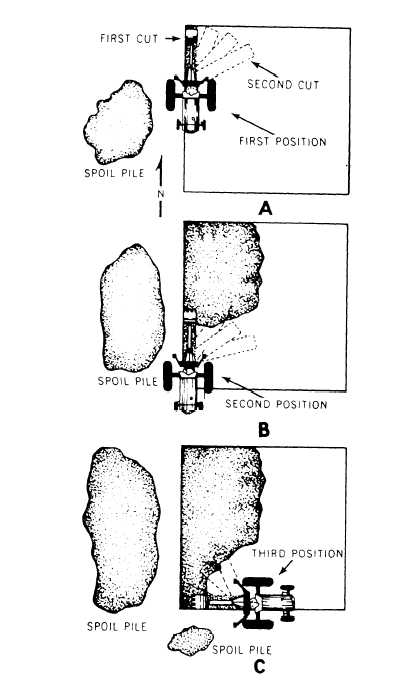requirements for disposal of the spoil. In all cases, the
starting point and digging sequence must be planned, so
the backhoe conveniently works itself out into the clear.
Improper procedures will not only trap the machine, but
can lead to situations where the machine cannot be
positioned to complete the job. In this situation, hand
digging may be required to complete the excavation.
An accepted starting and digging sequence that can
be followed for excavating a small foundation is shown
in figure 9-63. Remember that digging time is lost each
Figure 9-63.—Foundation excavation.
time the machine must be moved. The digging sequence
is planned, so a maximum amount of spoil can be
excavated before the machine is moved to the next
position.
For example, the first cut is to be made on the west
line (fig. 9-63, view A). The starting position of the
machine would be on the west line at a point where the
boom and dipper stick will reach the northwest corner.
The machine and boom are lined up parallel with the
west cutting line, so the outer edge of the bucket is
exactly in line with the cutting line.
The first cut is made by digging a ditch along the
west cutting line. The ditch should be dug to its full depth
and grade. This depth and grade serves as a depth guide
for the other cuts. When the west wall has been dug as
close as possible to the machine position, you then
swing the boom to reach near the center of the north
cutting line. The second cut, as shown in figure 9-63,
view A, is made by digging a trench back from the north
wall. The material cut in the angle formed between these
two trenches is removed in layers until the bottom grade
is reached.
NOTE: Ensure that the desired grade is reached
before moving the backhoe.
The backhoe is then backed up into the second
position, as shown in figure 9-63, view B. Digging is
continued in steps, as shown in figure 9-63, view A. The
ditch is dug first along the west line. The boom is then
swung around to cut the angle trench and the material is
removed to grade. Digging is continued in this manner
until the south line is reached.
The backhoe is then moved to the unexcavated
portion of the south line. This position is shown in figure
9-63, view C. Here, the backhoe is positioned with the
bucket in the excavation at the southwest corner to begin
the ditch along the south cutting line. Again, after the
ditch is dug along the cutting line, you should swing the
boom toward the center to remove as much spoil as
possible from this machine position.
You should continue to move the backhoe around
the excavation, repeating the digging steps until all four
cutting lines are cut and the spoil removed. To make the
final cut to remove the material, you may have to
position the machine at the edge so the bucket can dig
straight up. This cannot be done unless the soil type is
known to have good-bearing qualities. Cave-ins will
result if the soil will not support the weight of the
machine.
NOTE: Before excavating at a jobsite, always
consult with the project supervisor or crew leader about
your excavation plans. Keep in mind that the area you
9-28

